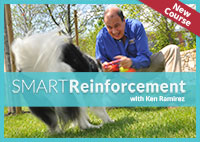Originally published on 02/04/2013
Really?
That title is a typo, right? A professional dog trainer would never advocate against socialization, would she? Well, maybe!
The problem isn't with socialization itself, but with many people's understanding of socialization. Socialization is vital for proper mental and social development in dogs, and it needs to be offered properly. Mistakes in socialization, even if intentions are good, can backfire and may even produce an overly shy or overly aggressive dog.

When NOT to socialize a puppy
Good socialization introduces a puppy or dog to something new, maybe even challenges the dog a little. Good socialization provides a positive experience for the dog.
It was a weird floor surface, but we were able to play cool games on it. That guy had the strangest hat ever, but he knew how to play the target game for treats!
It's all about showing a puppy new things and letting the puppy "win" in the challenge presented. But too often people think only of showing the puppy new things, without taking care that the puppy feels very successful. In fact, sometimes what people intend as helpful socialization creates more problems than it prevents.
As an example, consider the well-meaning but potentially dangerous recommendations to "Touch his feet and ears a lot so he gets used to handling," and "Play with his food while he's eating so he learns that is okay." Without specifically making sure that the puppy enjoys both the interaction and outcome, these actions can sensitize a dog to handling and food approach.
Any time a puppy is not actively enjoying the socialization experience (at least by the end—it's okay if he learns to overcome a short challenge), there is the potential for doing more harm than good. Refer to the checklist in the sidebar for key points to a good socialization experience.
Socialization Checklist
- Does the dog have an escape route? (Can he move away from the motorcycle or the funny hat or the other dog?)
- Is the dog using the escape route repeatedly, or is he reluctant to come back to the challenge? (If so, the challenge is probably too challenging!)
- Is the dog coming back of his own volition? (That's a good thing, as it means you are keeping the challenge level with his curiosity!)
- Are you using food to lure the dog back? This is very common, but in my opinion it's a mistake. This demonstrates not the dog's comfort level, but the magnetism of the food. I sometimes see dogs drawn into an uncomfortable location by food, focusing on the food to avoid seeing the scary parts. When the food is gone, these dogs look up and "suddenly" have a fear reaction. I use lots of food in training, of course, but food is for rewarding, not bribing!
When NOT to socialize an adult dog
What if you have an adult dog? Maybe you made some socialization mistakes, or you inherited a bad socialization legacy along with the dog. In either case, socialization experiences aren't as they should be. Is there hope?
Yes, of course there's hope! But mistakes happen in the name of socialization with grown dogs, too. I get a lot of phone calls that run like this:
DOG OWNER: "Hi, I'd like to sign up for a class."
TRAINER: "Great! Are you interested in a group session or private training?"
DOG OWNER: "We want a group class. We want the socialization."
(Note: This phrase is the most poisoned of cues for a professional trainer. It indicates either a dedicated dog owner trying hard to do everything right, or an owner in denial regarding potentially dangerous behavior.)
TRAINER: "Yes, socialization is very important…. Can you tell me exactly what you're looking for?"
DOG OWNER: "He just needs to get used to other dogs."
TRAINER: "What does he do now around other dogs?"
DOG OWNER: "He pulls really hard, barks, jumps, won't listen…. Sometimes his hair stands up. So we know he needs socialization."
TRAINER: "Okay. He sounds like he gets pretty worked up? Tell you what, let's do a private session…"
DOG OWNER: "Oh, no, we don't want private training—he's great at home. He needs to learn to be around other dogs."
Truth
Yes, that dog needs to learn to be around other dogs. But he's probably not going to learn well in a group class. A dog with an over-the-top reaction is a dog too aroused to think clearly, process information, and retain knowledge for later. In short, that dog is not going to learn, and I'd be wasting your time and money if I took that dog in a group class!
Not to mention putting other dogs at risk of a bad socialization experience.
Recently I had a client who did not want to waste time on a foundation lesson, who wanted to have the first lesson in the trigger situation. I explained that this was equivalent to taking a brand-new student driver onto the interstate and then trying to explain gear shifts, turn signals, and left and right pedals—all at 65 mph. It's essential to have skills under stress; therefore, you have to learn them before you're under stress.
So my client took a few weeks to practice the basic skills first. In her second session she was utterly amazed as her large mastiff-type dog, a dog she could no longer walk due to the strength required to restrain his reactive lunging, lay quietly on a mat and responded to cues. He was aware of a second dog, but stable and focused. Yes, it was worth it.
Learning happens in a mind that is still engaged. It's important to start teaching the dog new behaviors while he is still under threshold—and that's not going to be in a room with five other new dogs.
"Pet" peeves
Not everyone recognizes the necessity of a foundation and of incremental steps. Instead, well-meaning owners, often thinking they're doing the right thing in "socializing," put their dogs (and other humans and dogs) in unfair situations—and sometimes even in danger.
Where does this seem to happen the most?
- popular walking/running/biking trails
- dog parks
- pet fairs and festivals
- community events
Most of these environments violate key points of the good-socialization checklist: the dog has no escape route and he cannot chose to leave and return of his own volition. Many people won't leave the trail mid-run or go home from the street fair after only twenty minutes if the dog is overwhelmed. So, the exposure continues and the dog gets more aroused. By the end he is really confirmed in his reactions.
Other people attending a community event did not sign up to rehabilitate a troubled dog; they came to enjoy a social outing. Putting a stressed dog in their midst neither helps the dog nor enhances attendees' enjoyment. At best, it only confirms public opinion that dogs are often nuisances and should be banned from public areas. At worst, it creates more problems for the dog and puts others in danger.
While I am a clicker trainer, look for positive alternatives, and wholly advocate non-violent solutions, I am rapidly approaching an unwelcome point. If I have to intervene again to prevent a dog fight or a bite to a child while a dog owner explains that he or she is deliberately putting the dog in an overwhelming situation "to work on socialization," there's a good chance I will need bail and an attorney!
If you are not willing to retreat if your dog needs it, do not take the dog with you. Period. If your dog is too aroused and cannot recover, your training isn't yet ready for the scenario. You need to quit before you create more problems. End of discussion.
Here's the positive!
There are better ways to socialize your puppy or adult dog than to jump right in to group classes or wander far and wide searching out crowds of people and other animals. Successful training techniques prevent or solve problems instead of create them. Appropriate socialization training proceeds with steps, and ensures that the dog is ready to progress each time!
As illustrated by my client and her mastiff above, private training classes offer a fantastic head-start to socialization training. In a situation like that one with the mastiff, or any situation where an owner is looking to improve socialization skills responsibly, a good trainer will suggest a private session. At that initial or evaluation session, the dog starts learning new ways to interact with his environment and his human. Most importantly, he learns how to interrupt his own arousal. The next step is to teach him to choose relaxation in the presence of his triggers (other dogs, humans, etc.). These skills have to be learned before they can be used.
You can go, but where?
Not to rule out field trips altogether, though! There is plenty of room in a socialization training plan for outings, as long as anticipation and care are part of the package. So, where to go?
Match the scenario to the dog's current skill set. Has the dog ever been to a public event? If not, starting at the street fair with new asphalt substrates, a thousand people, several dozen food vendors, other (possibly stressed) dogs, music from the dance troupes, and the roar of engines from the car show is probably not a good choice for an outing. How about starting with the neighbor's cookout, where you can introduce your dog to fewer people and then pop him back home after he's had a good time?
When I take a dog out to socialize, particularly if I know it will be challenging for that dog, I make sure my schedule is clear of anything but that dog. If you really need to cover all of the fairground's antique booths before you go home, the dog shouldn't go. If it's more important that you keep a steady running pace than that your dog has a chance to self-assess and relax after a close bike encounter, the dog shouldn't go. That doesn't mean you can't ever run with the dog. It just means that you'll have to do some runs where you're willing to put dog training before your own training in order to get a great running partner for years to come.
At other times I will go somewhere for a longer period, but with the option to retreat as necessary. My car can be a very secure and safe place for a dog trained to relax comfortably in his crate. The car is protected from heat or cold and strangers, and can act as a base from which the dog can make forays into socialization experiences. Obviously, this is not an option for a dog that doesn't regard his crate in the car as a haven, or with a car that isn't safe.
What to do?
Once you've picked a good field trip, assess your dog's skills. What behaviors is he really fluent at right now? Sit? Target? My definition of a dog "knowing" a behavior is that I can slap $50 on the counter and say "Watch this!" and he'll perform promptly on the first cue to win my bet. If you don't have a $50 behavior yet, that needs to be taught before you venture out. There's no profit in trying to train a new behavior in a new environment.
The $50 behavior is your "canary in a coal mine." As long as that behavior is healthy, you're working beneath the dog's threshold. When the behavior begins to degrade—you ask the dog to sit, and he does it slowly, or he does it facing away instead of facing you as usual, or he displays some other variant you don't usually expect—be cautious. The dog is challenged. It might be time to back off for a while or change tactics.

Next, choose your goals for the outing; these will vary widely by dog and by situation. Would you like your pup to relax while bicycles pass, recognizing they're just background noise? Or do you need your shy dog to feel more comfortable passing or meeting strangers on the sidewalk? Has your dog seen gentlemen with big beards and ladies with long skirts?
What about other dogs, cats, horses (rural residents or urban police mounts), skateboards, motorcycles, and other things not normally found in your living room? Will your dog be meeting or just observing?
Out in the environment, start by asking for your "canary" behavior, and perhaps others, reinforcing generously. You want the dog to think that new environments are fun and pay well! Now watch for your dog catching interest in something or looking to explore. Go with him, verbally encouraging him gently and reinforcing appropriate behavior with petting or treats. (Remember the points from the socialization checklist!)
If the dog is hesitating, let him make a step or sniff forward, and reward that by tossing a piece of food to the ground in front of him. Don't use the food to lure him. Not only does luring disguise his natural behavior beneath the eating behavior (so that it is harder to read what the dog is feeling), but the dog was frozen when the food appeared and so freezing has been reinforced. If you start out luring, even as your dog grows more comfortable he will be less likely to move forward or explore his environment on his own. (If the dog is in distress, rescue or distract him, of course! But that is management, not training or socialization.)
When the dog is visiting with a stranger or sniffing the bicycle, know when to quit. Call back your pup before he gets too excited and displays frantic behavior, or before his courage fails and he finds himself facing more than he's ready to face. Stop at the peak of his experience! Call him back (don't pull) and reinforce coming to you. If you don't have enough of a recall yet, drop a series of treats and lead him back to you.
Get creative
While socializing should definitely include socializing with people, it should also include a lot more: floor textures, strange noises, different types of weather, odd smells. These experiences should all be a part of your socialization goals. Nearly anything can be turned into a great socialization experience for a puppy!
Sometimes necessity is the mother of all sorts of inventions. I drove across several states and was tired when I checked into my motel, but my 8-week-old puppy had slept much of the trip and was full of energy and enthusiasm! I filled the motel tub with an inch or two of water and floated several handfuls of kibble, creating a fun game for her. Simultaneously she could burn energy in a great play session, explore the properties of water and controlled splashing, and have an enjoyable experience in a bathtub. (It was an easy cleanup and I left no mess for the cleaning staff!)
Socialization success
If your dog needs socialization, please provide it in the doses he requires. Your dog will make much faster progress with a series of baby steps than with any overwhelming preliminary experiences. If you don't seem to be making progress with your dog's socialization training, consider professional help. You'll have more success with a good training protocol than just hoping things get better. With a good trainer, you certainly won't make things worse accidentally! In the end, you'll be the one knowing when, where, and how to socialize your dog.







